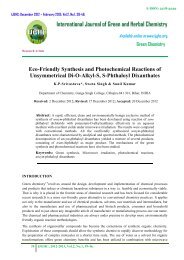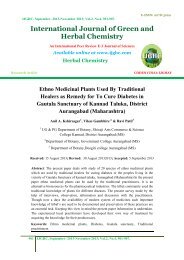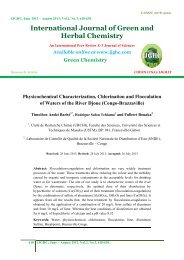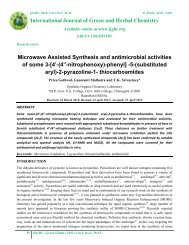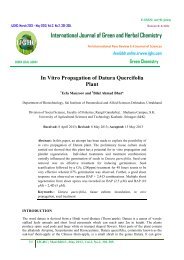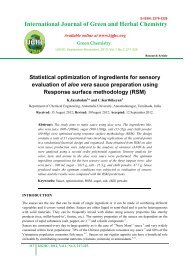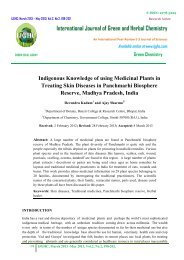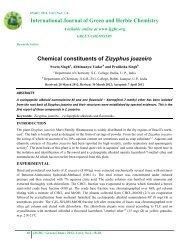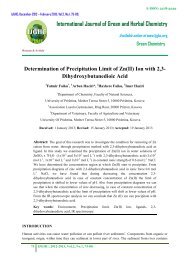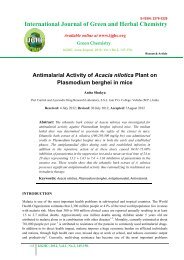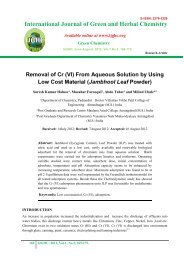Sustainable Marketing - A Theoretical Perspective - IJGHC
Sustainable Marketing - A Theoretical Perspective - IJGHC
Sustainable Marketing - A Theoretical Perspective - IJGHC
You also want an ePaper? Increase the reach of your titles
YUMPU automatically turns print PDFs into web optimized ePapers that Google loves.
<strong>IJGHC</strong>; December 2012 – February 2013; Vol.2, No.1, 149-153.<br />
E-ISSN: 2278-3229<br />
International Journal of Green and Herbal Chemistry<br />
Review Article<br />
An International Peer Review E-3 Journal of Sciences<br />
Available online at www.ijghc.com<br />
Green Chemistry<br />
<strong>Sustainable</strong> <strong>Marketing</strong> - A <strong>Theoretical</strong> <strong>Perspective</strong><br />
M. Padmavathi<br />
Department of Biotechnology, DVR & DR. HS MIC College of Technology,<br />
Kanchikacherla, A.P. India<br />
Received: 20 January 2013; Revised: 4 February 2013; Accepted: 6 February 2013<br />
Abstract: Green, environmental and eco-marketing are part of the new marketing<br />
approaches which do not just refocus, adjust or enhance existing marketing thinking and<br />
practice, but seek to challenge those approaches and provide a sustainability. Many<br />
consumers are environmentally conscious, seeking eco-friendly products and services<br />
from organizations that are socially responsible. The present paper gives the idea of all<br />
the implications of green marketing, product processing and packaging principles to<br />
reduce pollution and to protect the environment.<br />
Key words: Green marketing, Green consumers, Green washing and Green labelling.<br />
INTRODUCTION<br />
Green marketing is the process of selling products or services based on their environmental benefits. The<br />
product or service should be an eco-friendly one. Green marketing is the marketing of products that are<br />
presumed to be environmentally safe 1 . Green marketing is the potential consumers will view a product or<br />
service's "greenness" as a benefit and base their buying decision. Assumption of green marketing is that<br />
consumers will be willing to pay more for green products than they would for a less-green comparable<br />
alternative product. Green marketing is growing greatly as increasing numbers of consumers.<br />
Thus green marketing shows a broad range of activities, including product modification, changes to the<br />
production process, packaging changes, as well as modifying advertising. The meaning of green<br />
marketing is different in the existence of varying social, environmental and retail definitions attached to<br />
this term 1 . This ecological marketing also referred as green marketing or environmental marketing or eco<br />
marketing. Eco-marketing belongs to the group of approaches which seek to address the lack of fit<br />
between marketing as it currently practiced and the ecological and social realities of the wider marketing<br />
environment 2 .<br />
149 <strong>IJGHC</strong>; 2012-2013, Vol.2, No.1, 149-153.
<strong>Sustainable</strong>...<br />
M. Padmavathi<br />
The term Green <strong>Marketing</strong> came into familiar in the late 1980s and early 1990s 3 . The American<br />
<strong>Marketing</strong> Association (AMA) held the first workshop on "Ecological <strong>Marketing</strong>" in 1975 4 .The<br />
proceedings of this workshop resulted in a book on green marketing entitled "Ecological <strong>Marketing</strong>" 5 . In<br />
1987 a document prepared by the World Commission on Environment and Development (WCED)<br />
defined sustainable development as meeting “the needs of the present without compromising the ability<br />
of future generations to meet their own need”, this became known as the Brundtland Report and was<br />
another step towards widespread thinking on sustainability in everyday activity. Green marketing came in<br />
the form of publication by Ken Peattie (1992) in the United Kingdom and by Jacqelyn Ottman (1993) in<br />
the United States of America 6 . Jacqelyn also wrote a book on "The New Rules of Green <strong>Marketing</strong>:<br />
Strategies, Tools, and Inspiration for <strong>Sustainable</strong> Branding" 7 . In this, he mentioned an organizational<br />
standpoint; environmental considerations should be integrated into all aspects of marketing — new<br />
product development and communications. In this, he suggests besides suppliers and retailer’s new<br />
stakeholders, educators, members of the community, regulators, and NGOs are included. Environmental<br />
issues should be balanced with primary customer needs.<br />
Fig 1: Green marketing helps to protect the nature<br />
Consumer power to effect positive environmental change called as ‘Green consumer’ 8 . In essence, there<br />
is no definition of "how good is good enough" when it comes to a product or company making green<br />
marketing claims. This lack of consensus—by consumers, marketers, activists, regulators, and influential<br />
people—has slowed the growth of green products, says Makower, because companies are often reluctant<br />
to promote their green attributes, and consumers are often skeptical about claims.<br />
Green marketing has continued to gain adherents, particularly in light of growing global concern about<br />
climate change. This concern has led more companies to advertise their commitment to reduce their<br />
climate impacts, and the effect this is having on their products and services 9, 10 .<br />
Green house gases are the one more dangerous to the environment. Therefore, the main aim of the green<br />
marketing is to reduce this and provide safety to the product. Green house gas 11<br />
http://en.wikipedia.org/wiki/Green_marketing - cite_note-14reduction holds substantial promise as a<br />
source of new funding for sustainable development. To facilitate participation and broaden the benefits,<br />
several barriers must be overcome, such as lack of market awareness among stakeholders and prospective<br />
participants, specialized, complicated participation rules, and the need for simplified participation<br />
mechanisms for small projects, without which transaction costs can overwhelm the financial benefits of<br />
participation. Greenhouse gas trading can play an important role supporting activities that<br />
benefit peoples’s lives and the environment.<br />
Despite the growth in the number of green products, green marketing is on the decline as the primary<br />
sales pitch for products.<br />
150 <strong>IJGHC</strong>; 2012-2013, Vol.2, No.1, 149-153.
<strong>Sustainable</strong>...<br />
M. Padmavathi<br />
One challenge green marketers -- old and new -- are likely to face as green products and messages<br />
become more common are confusion in the marketplace. "Consumers do not really understand a lot about<br />
these issues, and there's a lot of confusion there," says Jacquelyn Ottman 12 . Marketers sometimes take an<br />
advantage of this and purposely make false or exaggerated "green" claims referred as "green washing”.<br />
The primary objective of green washing is to provide consumers with the feeling that the organization is<br />
taking the necessary steps to responsibly manage its ecological footprint. In reality, the company may be<br />
doing very little that is environmentally beneficial 13 . Environmentalist Jay Westerveld first used the term<br />
green washing. Green washing has become a central feature of debates about marketing communications<br />
and sustainability, with “awards” for green washing established and numerous campaigns, law and<br />
advices developed in an attempt to reduce or curb it.<br />
In January of 2012, Patagonia became the first brand to register for "Benefit Corporation" status 14 . A<br />
benefit corporation is an alternative to its standard counterpart as it operates under the legal premise of<br />
(1) creating a positive impact socially and environmentally in its materials,(2) uphold Corporate Social<br />
Responsibility in terms of considering its workers, its community, and the environment as well as<br />
challenge its current boundaries in those areas, and (3) report its activity as a company as well as its<br />
achievements in social and environmental areas publicly using a non-partisan third party source.<br />
Year by year the adoptability of the green market increases not only in a country but also throughout the<br />
world. An important challenge facing marketers is to identify which consumers are willing to pay more<br />
for environmentally friendly products. It is apparent that an enhanced knowledge of the profile of this<br />
segment of consumers would be extremely useful.<br />
Five factors can help to determine whether a new idea will be adopted or not, including the idealism of<br />
the shift towards “green”. These are<br />
• Relative advantage<br />
• Observability<br />
• Trialability<br />
• Compatibility<br />
• Complexity<br />
LOHAS stands for Lifestyles of Health and Sustainability, and describes an integrated, rapidly growing<br />
market for goods and services that appeal to consumers whose sense of environmental and social<br />
responsibility influences their purchase decisions.<br />
A model of a green marketing mix should, of course, contain all 8P’s:<br />
• Product: The product should be eco-friendly and should not contaminate or damage environment.<br />
• Price: Prices of these products may be a little higher than the conventional. But they are willing to pay<br />
extra for green products.<br />
• Place: It is the crucial importance and focus for ecological packaging. Local marketing and seasonal<br />
products such as vegetables from region farms is easier to be marketed “green” than products<br />
imported.<br />
• Promotion: The product should have ISO 14000 certification to improve a firm’s image. Company’s<br />
expenditure on environmental protection, sponsoring the natural environment and ecological products<br />
requires special sales promotions.<br />
• Publics: Effective social marketing and public external or internal who involved in this either approval<br />
or implementation of the program.<br />
• Purse Strings- The strategic effort cost and the funding effort are important for it 15 .<br />
151 <strong>IJGHC</strong>; 2012-2013, Vol.2, No.1, 149-153.
<strong>Sustainable</strong>...<br />
M. Padmavathi<br />
• Partnership-Social change issues, including "green" initiatives, are too complex for one person or<br />
group to handle up strengthens and the chance of efficacy.<br />
• Policy- Social marketing programs in motivating individual behavior change, it is difficult to sustain<br />
unless the environment supports it for the long run.<br />
Fig 2: 8 P’s helps to prevent the pollution<br />
The Green labelling is necessary to prevent the skepticism i.e., various factors such as lack of language,<br />
the absence of scientific knowledge necessary to interpret advertising meaning, and, in particular, the<br />
falsehoods and exaggeration of some advertising techniques. To resolve this problem, independent<br />
organizations may choose to guarantee messages on the environmental benefits of brands with<br />
environmental labelling systems sponsored by independent organizations. The aim of improving<br />
confidence in the evaluation of environmental benefits of products—all of which should positively affect<br />
the purchase intention.<br />
Recycled products for example, are one of the most popular alternatives that can benefit the environment<br />
such as plastics, bangles, tins, rags, paper etc., These benefits include sustainable forestry, clean air,<br />
energy efficiency, water conservation, and a healthy office. Like this introduction of CNG in public<br />
transport systems to curb pollution.<br />
CONCLUSION<br />
152 <strong>IJGHC</strong>; 2012-2013, Vol.2, No.1, 149-153.<br />
Fig3: Green market saves our lives<br />
Green marketing or ecological marketing helps to reduce pollution as a result the flora and fauna would<br />
be safe in the environment, the man lives happily with sustainable marketing. Each and every product
<strong>Sustainable</strong>...<br />
M. Padmavathi<br />
should contain the green label to know eco-friendly product even for an illiterate to understand about the<br />
product. Then only the consumers can purchase the product even it is high rate to maintain the<br />
sustainability.<br />
REFERENCES<br />
1. "Green Trade & Development" (html). Green Markets International, Inc. Retrieved January 2008.<br />
2. F. Belz K. Peattie Sustainability <strong>Marketing</strong>: A Global <strong>Perspective</strong>. John Wiley & Sons, 2009<br />
3. Dodds, John (May 21, 2007). "Green <strong>Marketing</strong> 101" 2008<br />
4. Curtin, Emily (2006-09-14). "Lower East Side Green Market". January 2008<br />
5. E Karl., Henion; C.Thomas Kinnear "Ecological <strong>Marketing</strong>". Ecological <strong>Marketing</strong>. American <strong>Marketing</strong><br />
Association Jan 1996, pp. 168.<br />
6. "Green <strong>Marketing</strong>: Challenges & Opportunities for the New <strong>Marketing</strong> Age" 2010<br />
7. "Greenleaf publishing bookshop" and "Green <strong>Marketing</strong>" 2010<br />
8. Mendleson, N. Icola; Michael Jay Polonsky "Using strategic alliances to develop credible green<br />
marketing". Journal of Consumer <strong>Marketing</strong> (MCB UP Ltd) 12 (2) , 1995 : 4–18.<br />
9. McDaniel, W. Stephen.; H. David Rylander "Strategic green marketing". Journal of Consumer<br />
<strong>Marketing</strong> (MCB UP Ltd) 10 (3) 1993 : 4–10.<br />
10. L Thomas. Friedman "The Power of Green". The New York Times, April 15, 2007<br />
11. Ottman, Jacquelyn "The Real News About Green Consuming". Retrieved January 2008.<br />
12. E Orange, From eco-friendly to eco-intelligent. THE FUTURIST, September–October 2010, 28-32.<br />
13. King, Bart. "Patagonia Is First to Register for ‘Benefit Corporation’ Status in California" 2012<br />
14. Weinreich, Nedra. "What is Social <strong>Marketing</strong>" 2012<br />
15. F.J Montoro-Rios, T Luque-Martinez, and M.-A Rodriguez-Molina, (2008): How Green Should You Be:<br />
Can Environmental Associations Enhance Brand Performance Journal of advertising research, December<br />
2008, 547-563.<br />
Corresponding author: M. Padmavathi; Department of Biotechnology, DVR & DR.<br />
HS MIC College of Technology, Kanchikacherla, A.P. India<br />
153 <strong>IJGHC</strong>; 2012-2013, Vol.2, No.1, 149-153.



